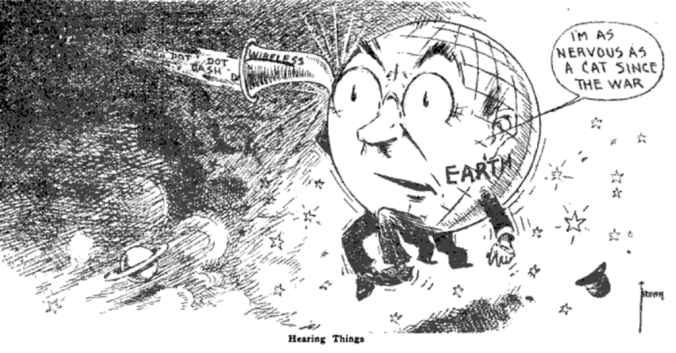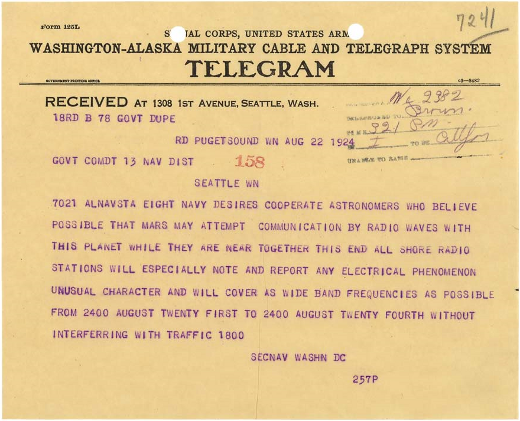If intelligent aliens exist and they were trying to communicate remotely with the inhabitants of earth, would we have the technical capabilities to detect their signals? This question, of course, has preoccupied both ufologists and researchers associated with the the Search for Extraterrestrial Intelligence (SETI). Since the early 1960s, radio telescope technology has played the key role in how academic astronomers have attempted to address this question.
But even before the first reports of “flying saucers” in 1947, there were a number of prominent figures who believed it possible to recognize and possibly decipher messages from intelligent aliens. The key, it was believed, was radio waves.
By the early part of the twentieth century, it was widely believed that planets in our solar system – most particularly, Mars and Venus – were in all likelihood inhabited by extraterrestrial civilizations. In 1901, inventor Nikola Tesla (1856-1943) announced that he had encountered odd electrical disturbances in his lab, “with such a clear suggestion of number and order” that he believed they could only be considered signals from Mars. “The feeling is constantly growing on me,” he explained, “that I had been the first to hear the greeting of one planet to another. A purpose was behind these electrical signals.” (1)

From: The Wireless Age, 7 (March 1920)
Years later, radio inventor Guglielmo Marconi (1874-1937) claimed to have had a similar experience, convinced that in 1919 he too had intercepted messages from Mars. A year later, Marconi reported that his wireless instruments were “occasionally [getting] very queer sounds and indications, which might come from somewhere outside the earth.” While he conceded that he had not “the slightest proof of their origin,” when asked if the signals might be made by another planet trying to communicate with earth, he replied, “I would not rule out the possibility of this…” Mars was widely seen as the likeliest candidate. And while the notion of Martian radio signals was greeted by some engineers and scientists at the time to be little more than wild speculation, others believed the possibility was worth serious study. (2)

The interest in the possibility of using radio technology to hear communications from Martians eventually culminated in a remarkable event in 1924. American astronomer David Peck Todd (1855-1939) had earlier argued that if there were indeed inhabitants on Mars, they might well try to communicate with Earth when the planets were relatively close to one another. On 21 August 1924, this occurred. And in preparation, a “National Radio Silence Day” was promoted throughout the United States. Owners were asked to keep radios silent for five minutes every hour so that a radio receiver at the U.S. Naval Observatory, lifted in a dirigible three kilometers off the ground, could be used to listen for any signals coming from the red planet. Todd and a navy admiral led the program, while an army cryptographer was on hand to translate any messages received. In the end, however, no signals were detected. (3)

1. Florence Raulin Certeau, “Fraction of Civilizations That Develop a Technology That Releases Detectable Signs of Their Existence into Space, fc, pre-1961″ in The Drake Equation: Estimating the Prevalence of Extraterrestrial Life Through the Ages, ed. Douglas A. Vakoch and Matthew F. Dowd, (Cambridge: Cambridge University Press, 2015), 219-220.
2. “Interplanetary Radio Signals? Varied Views on the Question Whether Inhabitant of Mars Have Been Trying to Signal Us by Radio,” The Wireless Age, 7 (March 1920): 11-15.
3. Certeau, “Fraction,” 221.

Ironic that, years later, it would become a fine-able offense for a licensed radio station to broadcast “silence” without powering down the tower.
LikeLike
Pingback: Quick Fact: In August 1924, when Mars get close enough to Earth... - Quick Facts
Pingback: In 1924, the US had "Radio Silence Day"... - Crazy Facts
Pingback: A Message from Mars - Dialog